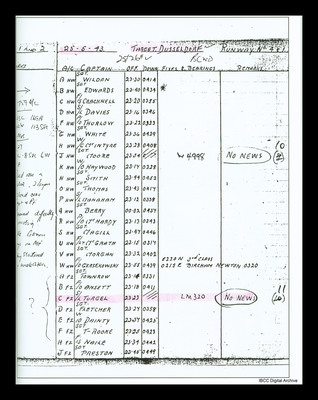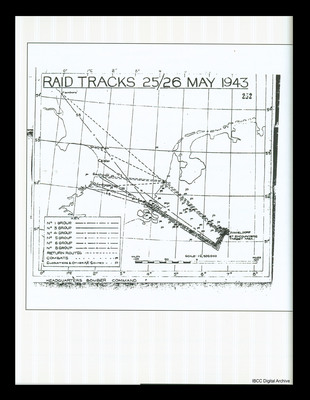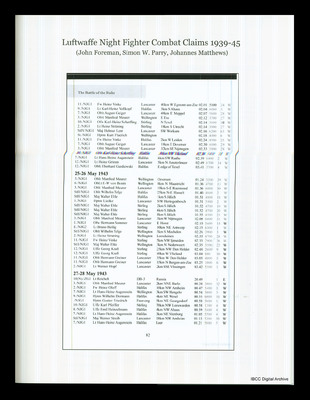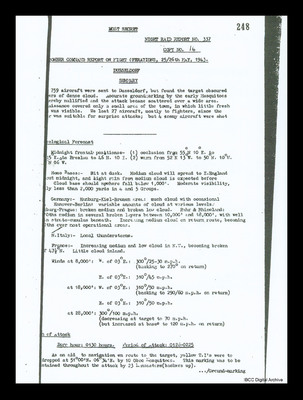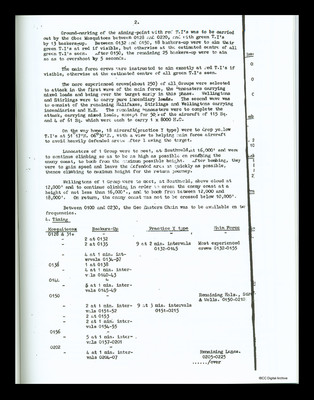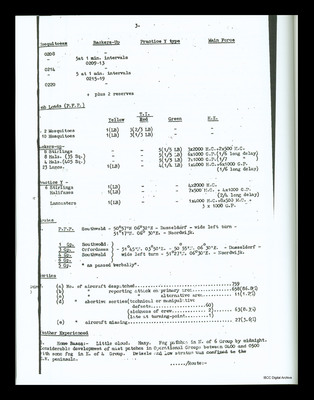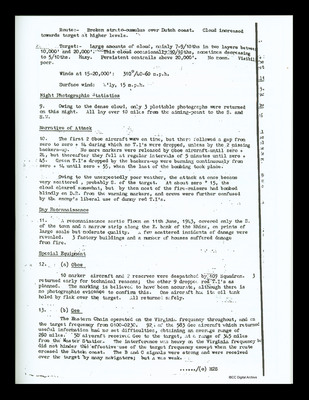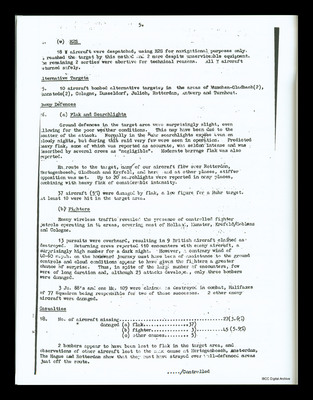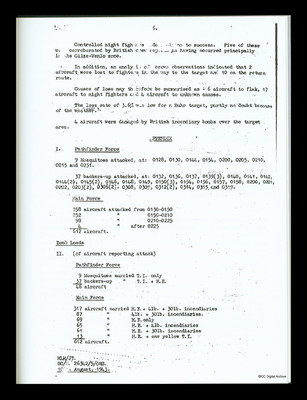Details operation to Dusseldorf 25/26 May 1943
Title
Details operation to Dusseldorf 25/26 May 1943
Description
This was the operation on which Ian Wynn's aircraft was lost. Captain was Squadron Leader P R Turgel. Item contains: 1. A list of crews on the operation. 2. Map of routes to target. 3. Luftwaffe night fighter combat claims for 25/26 May 1943. 4. Bomber command report on night operations 25/26 May 1943 which includes weather, details of attack including route and target marking, timing including Mosquito pathfinders, details of operation results, H2S, enemy defences (anti-aircraft fire and fighters), casualties, appendix with statistics of operation.
Spatial Coverage
Language
Format
Nine photocopied pages
Publisher
Rights
This content is available under a CC BY-NC 4.0 International license (Creative Commons Attribution-NonCommercial 4.0). It has been published ‘as is’ and may contain inaccuracies or culturally inappropriate references that do not necessarily reflect the official policy or position of the University of Lincoln or the International Bomber Command Centre. For more information, visit https://creativecommons.org/licenses/by-nc/4.0/ and https://ibccdigitalarchive.lincoln.ac.uk/omeka/legal.
Contributor
Identifier
BWynnWynn1501-036, BWynnWynn1501-037, BWynnWynn1501-038, BWynnWynn1501-039, BWynnWynn1501-040, BWynnWynn1501-041, BWynnWynn1501-042, BWynnWynn1501-043, BWynnWynn1501-044
Transcription
[underlined] 1 AND 2 25-5-43 TARGET DUSSELDORF [symbol] RUNWAY No. 4 & 1 [/underlined]
25/26th [symbol] BCWD
[heading] [underlined] [missing word] – A/C – CAPTAIN – OFF – DOWN – FIXES & BEARINGS – REMARKS [/underlined] [/heading]
[blank] – A HW – SGT. WILDEN – 23.30 – 0414 – [blank] – [blank]
[symbol] – B HW – SGT EDWARDS – 23.40 – 0434 – [symbol] – [blank]
759 A/C – C HW – F/S CRACKNELL – 23.20 – 0355 – [blank] – [blank]
23C 169H – D HW – S/L DAVIES – 23.16 – 0346 – [blank] – [blank]
[missing word] 113STR – F HW – P/O THURLOW – 23.22 – 0323 – [blank] – [blank]
[missing word] G HW – SGT. WHITE – 23.36 – 0429 – [blank] – [blank]
27 – H HW – W/C McINTYRE – 23.28 – 0408 – [blank] – [blank]
L.8 STC 6W – J HW – SGT. MOORE – 23.54 – [deleted] [indecipherable number] [/deleted] – W4998 – [circled NO NEWS] [deleted] (9) [/deleted] [inserted] -10 [/inserted]
[missing word] – K HW – W/O HAYWOOD – 23.17 – 0328 – [blank] – [blank]
[indecipherable words] – N HW – SGT. SMITH – 23.44 – 0452 – [blank] – [blank]
[indecipherable words] – O HW – SGT. THOMAS – 23.43 – 0417 – [blank] – [blank]
Cloud over [indecipherable word] & PF – P HW – S/L MANAHAM – 23.12 – 0338 – [blank] – [blank]
[indecipherable word] difficulty – Q HW – SGT. BERRY – 00.02 – 0437 – [blank] – [blank]
[indecipherable word] – R HW – P/O McHARDY – 23.13 – 0343 – [blank] – [blank]
[missing word] German – S HW – SGT. MAGILL – 23.47 – 0446 – [blank] – [blank]
[indecipherable words] – U HW – F/LT McGRATH – 23.15 – 0317 – [blank] – [blank]
[indecipherable words] – V HW – SGT. MORGAN – 23.32 – 0402 – [blank] – [blank]
[indecipherable word] – W HW – F/O GERSEKOWSKI – 23.55 – 0439 – 5220N [indecipherable word] CLASS 0215 E Bircham Newton 0320 – [blank]
? [brackets] [blank] A FZ – SGT. TOWNROW – 23.14 – 0331 – [blank] – [blank]
[blank] – B FZ – F/O ANSETT – 23.18 – 0411 – [blank] – [blank]
[blank] – C FZ – S/L TURGEL – 23.23 – [blank] – LM320 – [Circled NO NEWS] [deleted] (10) [/deleted] [inserted] 11 [/inserted]
[blank] – D FZ – SGT. FLETCHER – 23.27 – 0358 – [blank] – [blank]
[blank] – E FZ – W.O DAINTY – 23.37 – 0425 – [blank] – [blank]
[blank] – F FZ – SGT. T-ROOKE – 23.25 – 0423 – [blank] – blank]
[blank] – H FZ – F/S NAILE – 23.34 – 0442 – [blank] – [blank]
[blank] – J FZ – SGT PRESTON – 23.45 – 0449 – [blank] – [blank] [/brackets]
[page break]
[underlined] RAID TRACKS 25/26 MAY 1943 [/underlined]
252
[diagram of the raid tracks for Nos. 1, 3, 4, 5, 6 and 8 Groups showing their return routes and combats and encounters]
[page break]
Luftwaffe Night Fighter Combat Claims 1939-45
(John Foreman, Simon W. Parry, Johannes Matthews)
The Battle of the Ruhr
11./NJG1 – Fw Heinz Vinke – Lancaster – 40 km W Egmont-am See – 02.01 – 5100 – 24 – W
9./NJG1 – Lt Karl-Heinz Vollkopf – Halifax – 3km S Ahaus – 02.04 – 6000 – 3 – W
7./NJG1 – Oblt August Geiger – Lancaster – 48km E Meppel – 02.07 – 5600 – 28 – W
3./NJG1 – Oblt Manfred Meurer – Wellington – E Ess – 02.12 – 3700 – 27 – W
10./NJG1 – Ofw Karl-Heinz Scherfling – Stirling – N Texel – 02.14 – 3600 – 10 – W
2./NJG1 – Lt Heinz Strüning – Stirling – 18km S Utrecht – 02.14 – 3000 – 27 – W
StIV/NJG1 – Maj Helmut Lent – Lancaster – SW Workum – 02.16 – 6200 – 63 – W
St./NJG1 – Hptm Kurt Fladrich – Wellington – [blank] – 02.18 – 4000 – 6 – W
11./NJG1 – Fw Heinz Vinke – Halifax – 2km W Leiden – 02.24 – 4900 – 25 – W
7./NJG1 – Oblt August Geiger – Lancaster – 18km E Devemer – 02.30 – 6000 – 29 – W
3./NJG1 – Oblt Manfred Meurer – Lancaster – 32km – SE Nijmegen – 02.33 – 5800 – 28 – W
10/NJG1 – Ofw Karl-Heinz Scherfling – Halifax – 30km NW Vlieland – 02.36 – 5400 – 11 – W
7,/NJG1 – Lt Hans-Heinz Augenstein – Halifax – 6km SW Raalte – 02.39 – 6000 – 2 – W
12./NJG1 – Lt Heinz Grimm – Lancaster – 5km N Amsterlmeer – 02.49 – 6700 – 14 – W
12./NGJ1 – Oblt Eberhard Gardiewski – Halifax – E edge of Texel – 03.41 – 3700 – 4 – W
25-26 May 1943
3./NJG1 – Oblt Manfred Meurer – Wellington – Oostrum – 01.24 – 5200 – 29 – W
6./NJG1 – ObLt E-W von Bonin – Wellington – 8km N Maastricht – 01.36 – 4700 – 13 – W
3./NJG1 – Oblt Manfred Meurer – Lancaster – 10km S-E Roermond – 01.36 – 6800 – 30 – W
StII/NJG1 – Oblt Wilhelm Telge – Halifax – 25km N-E Hasselt – 01.40 – 4600 – 2 – W
StII/NJG1 – Maj Walter Ehle – Halifax – 1km S Jülich – 01.51 – 4800 – 18 – W
1./NJG1 – Hptm Liedke – Lancaster – NW Hertogenbosch – 01.51 – 5900 – 2 – W
StII/NJG1 – Maj Walter Ehle – Stirling – 2km S Jülich – 01.52 – 4700 – 19 – W
StII/NJG1 – Maj Walter Ehle – Stirling – 6 km S Jülich – 01.52 – 4700 – W
StII/NJG1 – Maj Walter Ehle – Stirling – 8km S Jülich – 01.55 – 4500 – 21 – W
3./NJG1 – Oblt Manfred Meurer – Lancaster – 5km W Nijmegen – 02.08 – 6600 – 31 – W
1./NJG1 – Ofw Hermann Sommer – Lancaster – E Horst – 02.10 – 5600 – 14 – W
E./NJG2 – Lt Bruno Heilig – Stirling – 10km NE Antwerp – 02.15 – 6300 – 1 – W
StII/NKJG1 – Oblt Wilhelm Telge – Wellington – 5km S Mechelen – 02.26 – 3900 – 3 – W
2./NJG1 – Lt Heinz Struning – Wellington – Loosduinen – 02.33 – 4700 – 28 – W
11./NJG1 – Fw Heinz Vinke – Stirling – 5km NW Ijmuiden – 02.33 – 2900 – 26 – W
StII/NJG1 – Maj Walter Ehle – Wellington – 3km N Nederweert – 02.35 – 3500 – 22 – W
12./NJG1 – Uffz Georg Kraft – Stirling – 25km NW Den Helder – 02.48 – 2600 – 9 – W
12./NJG1 – Uffz Georg Kraft – Stirling – 40km W Vlieland – 03.04 – 800 – 10 – W
11./NJG1 – Oblt Hermann Greiner – Lancaster – 35km W Den Helder – 03.05 – 4000 – 5 – W
11./NJG1 – Oblt Hermann Greiner – Lancaster – 15km N Bergen-am-Zee – 03.25 – 1000 – 6 – W
2./NJG1 – Lt Werner Hopf – Lancaster – 2km SSE Vlissingen – 03.42 – 5500 – 1 – W
27-28 May 1943
10(N)./ZG1 – Lt Reichelt – DB-3 – Russia – 20.49 – [blank] – 1 – E
3./NJG1 – Oblt Manfred Meurer – Lancaster – 2km NNE Barlo – 00.38 – 3000 – 32 – W
2./NJG1 – Fw Heinz Oloff – Halifax – 10km NW Arnheim – 00.47 – 5400 – 3 – W
7./NJG1 – Lt Hans-Heinz Augenstein – Wellington – 3km SW Hengelo – 00.54 – 5000 – 3 – W
9./NJG1 – Hptm Wilhelm Dormann – Halifax – 4km NE Wesel – 00.55 – 6000 – 10 – W
./NJG1 – Hptm Gunter Freidrich – Four-eng – 5km NE Geargodorf – 00.58 – 5600 – 1 – W
10./NJG – Uffz Karl Pfeiffer – Stirling – 70km NW Leeuwarden – 00.58 – 1300 – 4 – W
8./NJG1 – Uffz Emil Heinzelmann – Halifax – 4km NW Ahaus – 00.59 – 5400 – 4 – W
7./NJG1 – Lt Hans-Heinz Augenstein – Halifax – 3km NE Nienborg – 01.05 – 5500 – 4 – W
StI/NJG1 – Maj Werner Streib – Lancaster – 18km NW Arnheim – 01.15 – 5300 – 50 – W
7./NJG1 – Lt Hans-Heinz Augenstein – Halifax – Leer – 01.21 – 5000 – 5 – W
82
[page break]
248
[underlined] MOST SECRET
NIGHT RAID REPORT NO. 337
COPY NO. 16
BOMBER COMMAND REPORT ON NIGHT OPERATIONS, 25/26th MAY, 1943.
DUSSELDORF
SUMMARY [/underlined]
759 aircraft were sent to Dusseldorf, but found the target obscured [missing word] of dense cloud. Accurate groundmarking by the early Mosquitoes thereby nullified and the attack became scattered over a wide area. Reconnaissance covered only a small area of the town, in which little fresh [missing word] was visible. We lost 27 aircraft, mostly to fighters, since the [missing word] was suitable for surprise attacks; but 4 enemy aircraft were shot
[underlined] [missing letters] rological Forecast [/underlined]
Midnight frontal positions – (1) occlusion from 55o N 10o E. to [missing word] E. to Breslau to 46 N. 10 E. (2) warm from 52o N 13o W. to 50o N. 10o W. [missing number] N 06o W.
Home Bases:- Hit at dusk. Medium cloud will spread to E. England [missing letters]out midnight, and light rain from medium cloud is expected before [missing word] Cloud base should nowhere fall below 1,000’. Moderate visibility, [missing word] less than 2,000 yards in 4 and 5 Groups.
Germany:- Hamburg-Kiel-Bremen area: much cloud with occasional [missing word] Hanover-Berlin: variable amounts of cloud at various levels. [missing letters]nburg-Prague: broken medium and broken low cloud. Ruhr & Rhineland: [missing word] ths medium in several broken layers between 10,000’ and 18,000’, with well [missing word] strato-cumulus beneath. Increasing medium cloud on return route, becoming [missing word] ths over most operational areas.
N. Italy:- Local thunderstorms.
France:- Increasing medium and low cloud in N.W., becoming broken [missing word] 47 1/2o N. Little Cloud inland.
Winds at 8,000’: W. of 03o E.: 300o /25-30 m.p.h. (backing to 270o on return)
E. of 03o E.: 310o /45 m.p.h.
at 18,000’: W. of 03o E.: 310o /50 m.p.h. (backing to 290/60 m.p.h. on return)
E. of 03o E.: 310o /50 m.p.h.
at 28,000’: 300o /100 m.p.h. (decreasing at target to 70 m.p.h. (but increased at bases to 120 m.p.h. on return)
[underlined] [missing word] of Attack [/underlined]
[underlined] Zero hour: 0130 hours. Period of Attack 0128-0225 [/underlined]
As an aid to navigation en route to the target, yellow T.I’s were to [missing word] dropped at 51o 00’ N. 06o 34’ E. by 10 Oboe Mosquitoes. This marking was to be maintained throughout the attack by 23 Lancasters (backers up).
…/Ground-marking
[page break]
2.
Ground-marking of the aiming-point with red T.I’s was to be carried out by the Oboe Mosquitoes between 0128 and 0220, and with green T.I’s by 13 backers-up. Between 0132 and 0150, 18 backers-up were to aim their green T.I’s at red if visible, but otherwise at the estimated centre of all green T.I’s seen. After 0150, the remaining 25 backers-up were to aim so as to overshoot by 5 seconds.
The main force crews were instructed to aim exactly at red T.I’s if visible, otherwise at the estimated centre of all green T.I’s seen.
The more experienced crews (about 250) of all Groups were selected to attack in the first wave of the main force, the Lancasters carrying mixed loads and being over the target early in this phase. Wellingtons and Stirlings were to carry pure incendiary loads. The second wave to consist of the remaining Halifaxes, Stirlings and Wellingtons carrying incendiaries and H.E. The remaining Lancasters were to complete the attack, carrying mixed loads, except for 50 of the aircraft of 115 Sq. and 4 of 61 Sq. which were each to carry 1 x 8000 H.C.
On the way home, 18 aircraft (practice Y type) were to drop yellow T.I’s at 51o 17’ N. 06o 30’ E., with a view to helping main force aircraft to avoid heavily defended areas after leaving the target.
Lancasters of 1 Group were to meet, at Southwold, at 16,000’ and were to continue climbing so as to be as high as possible on reaching the enemy coast, to bomb from the maximum possible height. After bombing, they were to gain speed and leave the defended area as quickly as possible, thence climbing to maximum height for the return journey.
Wellingtons of 1 Group were to meet, at Southwold, above cloud at 12,000’ and to continue climbing in order to cross the enemy coast at a height of not less than 16,000’., and to bomb from between 12,000 and 18,000’. On return, the enemy coast was not to be crossed below 10,000’.
Between 0100 and 0230, the Geo Eastern Chain was to be available on two frequencies.
4. [underlined] Timing [/underlined]
[heading] [underlined] Mosquitoes – Backers-Up – Practice Y Type – Main force [/underlined] [/header]
0128 & 31+ - [blank] – [blank] – [blank]
[blank] – 2 at 0132 – [blank] – [blank]
[blank] – 2 at 0135 – 9 at 2 min. intervals 0132-0145 – Most experienced crews 0132-0155
[blank] – 4 at 1 min. intervals 0134-37 – [blank] – [blank]
0138 – 1 at 0138 – [blank] – [blank]
[blank] – 4 at 1 min. intervals 0140-43 – [blank] – [blank]
0144 – [blank] – [blank] – [blank]
[blank] – 5 at 1 min. intervals 0145-49 – [blank] – [blank]
0150 – [blank] – [blank] – Remaining Hals., Stirs & Wells. 0150-0210
[blank] – 2 at 1 min. intervals 0151-52 – 9 at 3 min. intervals 0151-0215 – [blank]
[blank] – 2 at 0153 – [blank] – [blank]
[blank] – 2 at 1 min. intervals 0154-55 – [blank] – [blank]
0156 – [blank] – [blank] – [blank]
[blank] – 5 at 1 min. intervals 0157-0201 – [blank] – [blank]
0202 – [blank] – [blank] – [blank]
[blank] – 4 at 1 min. intervals 0204-07 – [blank] – Remaining Lancs. 0205-0225
……/over
[page break]
3.
[heading] [underlined] Mosquitoes. – Backers-Up – Practice Y Type – Main Force [/underlined] [/heading]
0208 – [blank] – [blank] – [blank]
[blank] – 5 at 1 min. intervals 0209-13 – [blank] – [blank]
0214 – [blank] – [blank] – [blank]
[blank] – 5 at 1 min. intervals 0215-19 – [blank] – [blank]
0220 – [blank] – [blank] – [blank]
[blank] - + 2 reserves – [blank] – [blank]
[underlined] Bomb Loads (P.F.F.) [/underlined]
[underlined] T.I. [/underlined]
[heading] [blank] – [underlined] Yellow – Red – Green – H.E. [/underlined] [/heading]
2 Mosquitoes – 1 (LB) – 3 (2/3 LB) – [blank] – [blank]
10 Mosquitoes – 1 (LB) – 3 (1/3 LB) – [blank] – [blank]
[underlined] Backers-up- [/underlined]
8 Stirlings – [blank] – [blank] – 5 (1/5 LB) – 3 x 2000 H.C. + 2 x 500 M.C.
8 Hals. (35 Sq.) – [blank] – [blank] – 5 (1/5 LB) – 6 x 1000 C.P. (1/6 long delay)
4 Hals. (405 Sq.) – [blank] – [blank] – 5 (1/5 LB) – 7 x 1000 C.P. (1/7 “)
23 Lancs. – 1 (LB) – [blank] – 4 (1/4 LB) – 1 x 4000 H.C. + 6 x 1000 G.P. (1/6 long delay)
[underlined] Practice Y [/underlined]
6 Stirlings – 1 (LB) – [blank] – [blank] – 4 x 2000 H.C.
Halifaxes – 1 (LB) – [blank] – [blank] – 7 x 500 H.C. + 4 x 1000 G.P. (2/4 long delay)
Lancasters – 1 (LB) – [blank] – [blank] – 1 x 4000 H.C. + 8 x 500 H.C,. + 3 x 1000 G.P.
[underlined] Routes [/underlined]
[underlined] P.F.F. [/underlined] Southwold – 50o 57’ N 06o 32’ E – Dusseldorf – wide left turn – 51o 17’ N. 06o 30’ E – Noordwijk.
[brackets] [underlined] 1 Gp. [/underlined] Southwold [underlined] 3 Cp. [/underlined] Orfordness [underlined] 4 Gp. [/underlined] Southwold [underlined] 6 Gp. [/underlined] [blank] [underlined] 5 Gp. [/underlined] “as passed verbally”. [/brackets] – 51o 45’ N. 03o 50’ E. – 50o 55’ N. 06o 30’ E. – Dusseldorf – wide left turn – 51o 27’ N. 06o 30’ E. – Noordwijk.
[underlined] Sorties [/underlined]
[missing number] (a) No. of Aircraft despatched …………. 759
(b) “ reporting attack on primary area ………. 658 (86.8%)
(c) “ “ alternative area ……… 11 (1.2%)
(d) “ abortive sorties (technical or manipulative
[brackets] defects ……….. 60) (sickness of crew …….2) (late turning point…….1) [/brackets] …… 63 (8.3%)
(e) “ aircraft missing …………. 27 (3.6%)
[underlined] Weather Experienced [/underlined]
8. Home Bases:- Little cloud. Hazy. Fog patches in N. of 6 Group by midnight. Considerable development of mist patches in Operational Groups between 0400 and 0500 with some fog in E. of 4 Group. Drizzle and low stratus was confined to the S.W. peninsula.
……/Route:-
[page break]
Route:- Broken strato-cumulus over Dutch coast. Cloud increased towards target at higher levels.
[missing word] Target:- Large amounts of cloud, mainly 7-9/10ths in two layers between 10,000’ and 20,000’. This cloud occasionally 10/10ths, sometimes decreasing to 5/10ths. Hazy. Persistent contrails above 20,000’. No moon. Visibility poor.
Winds at 15-20,000’: 310o /40-60 m.p.h.
Surface wind: [indecipherable word] 15 m.p.h.
[underlined] Night Photographic Statistics [/underlined]
9. Owing to the dense cloud, only 3 plottable photographs were returned on this night. All lay over 10 miles from the aiming-point to the S. and S.W.
[underlined] Narrative of Attack [/underlined]
10. The first 2 Oboe aircraft were on time, but there followed a gap from zero to zero + 14 during which no T.I’s were dropped, unless by the 2 missing backers-up. No more markers were released by Oboe aircraft until zero + 24, but thereafter they fell at regular intervals of 5 minutes until zero + 45. Green T.I’s dropped by the backers-up were burning continuously from zero + 14 until zero + 55, when the last of the bombing took place.
Owing to the unexpectedly poor weather, the attack at once became very scattered, probably S. of the target. At about zero + 15, the cloud cleared somewhat, but by then most of the fire-raisers had bombed blindly on D.R. from the warning markers, and crews were further confused by the enemy’s liberal use of dummy red T.I’s.
[underlined] Day Reconnaissance [/underlined]
11. A reconnaissance sortie flown on 11th June, 1943, covered only the S. of the town and a narrow strip along the E. bank of the Rhine, on prints of large scale but moderate quality. A few scattered incidents of damage were revealed. 3 factory buildings and a number of houses suffered damage from fire.
[underlined] Special Equipment [/underlined]
12. (a) [underlined] Oboe [/underlined]
10 marker aircraft and 2 reserves were despatched by 109 Squadron. 3 returned early for technical reasons; the other 9 dropped red T.I’s as planned. The marking is believed to have been accurate, although there is no photographic evidence to confirm this. One aircraft had its oil tank holed by flak over the target. All returned safely.
13. (b) [underlined] Gee [/underlined]
The Eastern Chain operated on the Virginia frequency throughout, and on the target frequency from 0100-0230. 92, of the 583 Gee aircraft which returned useful information had no set difficulties, obtaining an average range of 260 miles. 50 aircraft received Gee to the target, at a range of 345 miles from the Master Station. The interference was heavy on the Virginia frequency but did not hinder the effective use of the target frequency except when the route crossed the Dutch coast. The B and C signals were strong and were received over the target by many navigators; but A was weak.
……/(c) H2S
[page break]
5.
(c) [underlined] H2S [/underlined]
18 Y aircraft were despatched, using H2S for navigational purposes only. 4 reached the target by this method and 2 more despite unserviceable equipment. The remaining 2 sorties were abortive for technical reasons. All Y aircraft returned safely.
[underlined] Alternative Targets [/underlined]
15. 10 Aircraft bombed alternative targets, in the areas of Munchen-Gladbach (2), Raamstede (2), Cologne, Dusseldorf, Julich, Rotterdam, Antwerp and Turnhout.
[underlined] Enemy Defences [/underlined]
16. (a) [underlined] Flak and Searchlights [/underlined]
Ground defences in the target area were surprisingly slight, even allowing for the poor weather conditions. This may have been due to the scatter of the attack. Normally in the Ruhr searchlights expose even on cloudy nights, but during this raid very few were seen in operation. Predicted heavy flak, some of which was reported as accurate, was seldom intense and was described by several crews as “negligible”. Moderate barrage flak was also reported.
En route to the target, many of our aircraft flew over Rotterdam, Hertogenbosch, Gladbach and Krefeld, and here and at other places, stiffer opposition was met. Up to 20 searchlights were reported in many places, combining with heavy flak of considerable intensity.
37 aircraft (5%) were damaged by flak, a low figure for a Ruhr target. At least 10 were hit in the target area.
(b) [underlined] Fighters [/underlined]
Enemy wireless traffic revealed the presence of controlled fighter patrols operating in 14 areas, covering most of Holland, Munster, Krefeld/Coblenz and Cologne.
13 pursuits were overheard, resulting in 9 British aircraft claimed as destroyed. Returning crews reported 110 encounters with enemy aircraft, a surprisingly high number for a dark night. However, a contrary wind of 40-60 m.p.h. on the homeward journey must have been of assistance to the ground controls and cloud conditions appear to have given the fighters a greater chance of surprise. Thus, in spite of the large number of encounters, few were of long duration and, although 23 attacks developed, only three bombers were damaged.
3 Ju. 88’s and one Me. 109 were claimed as destroyed in combat, Halifaxes of 77 Squadron being responsible for two of these successes. 2 other enemy aircraft were damaged.
[underlined] Casualties [/underlined]
18. No. of aircraft missing ……… 27 (3.6%)
“ damaged [brackets] (a) flak ….. 37 (b) fighter …… 3 (c) other causes ….. 5 [/brackets] ……. 45 (5.9%)
2 bombers appear to have been lost to flak in the target area, and observations of other aircraft lost to the same cause at Hertogenbosch, Amsterdam, The Hague and Rotterdam show that they must have strayed over well-defended areas just off the route.
…../Controlled
[page break]
6.
Controlled night fighters [two indecipherable words] to success. Five of these were corroborated by British crew reported as having occurred principally in the Gilze-Venlo zone.
In addition, an analysis of crews observations indicated that 2 aircraft were lost to fighters in [sic] the way to the target and 10 on the return route.
Causes of loss may therefore be summarised as – 6 aircraft to flak, 17 aircraft to night fighters and 4 aircraft to unknown causes.
The loss rate of 3.6% was low for a Ruhr target, partly no doubt because of the weather.
4 aircraft were damaged by British incendiary bombs over the target area.
[underlined] APPENDIX [/underlined]
I. [underlined] Pathfinder Force [/underlined]
9 Mosquitoes attacked, at: 0128, 0130, 0144, 0154, 0200, 0205, 0210, 0215 and 0231.
37 backers-up attacked, at: 0132, 0136, 0137, 0139 (3), 0140, 0141, 0142, 0144 (2), 0145 (2), 0146, 0148, 0149, 0150 (3), 0154, 0156, 0157, 0158, 0200, 0201, 0202, 0203 (2), 0306 (2), 0308, 0309, 0312 (2), 0314, 0315 and 0319.
[underlined] Main Force [/underlined]
258 aircraft attacked from 0130-0150
252 “ 0150-0210
98 “ 0210-0225
[underlined] 4 [/underlined] “ after 0225
612 aircraft
[underlined] Bomb Loads [/underlined]
II. (of aircraft reporting attack)
[underlined] Pathfinder Force [/underlined]
9 Mosquitoes carried T.I. only
[underlined] 37 [/underlined] backers-up “ T.I. + H.E.
46 aircraft
[underlined] Main Force [/underlined]
317 aircraft carried H.E. + 4 lb. + 30 lb. incendiaries
87 “ 4 lb. + 30 lb. incendiaries.
69 “ H.E. only
65 “ H.E. + 4 lb. incendiaries
61 “ H.E. + 30 lb. incendiaries
[underlined] 13 [/underlined] “ H.E. + one yellow T.I.
612 aircraft
MLM/JT.
BC/8 26342/5/OPS.
[underlined] 10th August, 1943. [/underlined]
25/26th [symbol] BCWD
[heading] [underlined] [missing word] – A/C – CAPTAIN – OFF – DOWN – FIXES & BEARINGS – REMARKS [/underlined] [/heading]
[blank] – A HW – SGT. WILDEN – 23.30 – 0414 – [blank] – [blank]
[symbol] – B HW – SGT EDWARDS – 23.40 – 0434 – [symbol] – [blank]
759 A/C – C HW – F/S CRACKNELL – 23.20 – 0355 – [blank] – [blank]
23C 169H – D HW – S/L DAVIES – 23.16 – 0346 – [blank] – [blank]
[missing word] 113STR – F HW – P/O THURLOW – 23.22 – 0323 – [blank] – [blank]
[missing word] G HW – SGT. WHITE – 23.36 – 0429 – [blank] – [blank]
27 – H HW – W/C McINTYRE – 23.28 – 0408 – [blank] – [blank]
L.8 STC 6W – J HW – SGT. MOORE – 23.54 – [deleted] [indecipherable number] [/deleted] – W4998 – [circled NO NEWS] [deleted] (9) [/deleted] [inserted] -10 [/inserted]
[missing word] – K HW – W/O HAYWOOD – 23.17 – 0328 – [blank] – [blank]
[indecipherable words] – N HW – SGT. SMITH – 23.44 – 0452 – [blank] – [blank]
[indecipherable words] – O HW – SGT. THOMAS – 23.43 – 0417 – [blank] – [blank]
Cloud over [indecipherable word] & PF – P HW – S/L MANAHAM – 23.12 – 0338 – [blank] – [blank]
[indecipherable word] difficulty – Q HW – SGT. BERRY – 00.02 – 0437 – [blank] – [blank]
[indecipherable word] – R HW – P/O McHARDY – 23.13 – 0343 – [blank] – [blank]
[missing word] German – S HW – SGT. MAGILL – 23.47 – 0446 – [blank] – [blank]
[indecipherable words] – U HW – F/LT McGRATH – 23.15 – 0317 – [blank] – [blank]
[indecipherable words] – V HW – SGT. MORGAN – 23.32 – 0402 – [blank] – [blank]
[indecipherable word] – W HW – F/O GERSEKOWSKI – 23.55 – 0439 – 5220N [indecipherable word] CLASS 0215 E Bircham Newton 0320 – [blank]
? [brackets] [blank] A FZ – SGT. TOWNROW – 23.14 – 0331 – [blank] – [blank]
[blank] – B FZ – F/O ANSETT – 23.18 – 0411 – [blank] – [blank]
[blank] – C FZ – S/L TURGEL – 23.23 – [blank] – LM320 – [Circled NO NEWS] [deleted] (10) [/deleted] [inserted] 11 [/inserted]
[blank] – D FZ – SGT. FLETCHER – 23.27 – 0358 – [blank] – [blank]
[blank] – E FZ – W.O DAINTY – 23.37 – 0425 – [blank] – [blank]
[blank] – F FZ – SGT. T-ROOKE – 23.25 – 0423 – [blank] – blank]
[blank] – H FZ – F/S NAILE – 23.34 – 0442 – [blank] – [blank]
[blank] – J FZ – SGT PRESTON – 23.45 – 0449 – [blank] – [blank] [/brackets]
[page break]
[underlined] RAID TRACKS 25/26 MAY 1943 [/underlined]
252
[diagram of the raid tracks for Nos. 1, 3, 4, 5, 6 and 8 Groups showing their return routes and combats and encounters]
[page break]
Luftwaffe Night Fighter Combat Claims 1939-45
(John Foreman, Simon W. Parry, Johannes Matthews)
The Battle of the Ruhr
11./NJG1 – Fw Heinz Vinke – Lancaster – 40 km W Egmont-am See – 02.01 – 5100 – 24 – W
9./NJG1 – Lt Karl-Heinz Vollkopf – Halifax – 3km S Ahaus – 02.04 – 6000 – 3 – W
7./NJG1 – Oblt August Geiger – Lancaster – 48km E Meppel – 02.07 – 5600 – 28 – W
3./NJG1 – Oblt Manfred Meurer – Wellington – E Ess – 02.12 – 3700 – 27 – W
10./NJG1 – Ofw Karl-Heinz Scherfling – Stirling – N Texel – 02.14 – 3600 – 10 – W
2./NJG1 – Lt Heinz Strüning – Stirling – 18km S Utrecht – 02.14 – 3000 – 27 – W
StIV/NJG1 – Maj Helmut Lent – Lancaster – SW Workum – 02.16 – 6200 – 63 – W
St./NJG1 – Hptm Kurt Fladrich – Wellington – [blank] – 02.18 – 4000 – 6 – W
11./NJG1 – Fw Heinz Vinke – Halifax – 2km W Leiden – 02.24 – 4900 – 25 – W
7./NJG1 – Oblt August Geiger – Lancaster – 18km E Devemer – 02.30 – 6000 – 29 – W
3./NJG1 – Oblt Manfred Meurer – Lancaster – 32km – SE Nijmegen – 02.33 – 5800 – 28 – W
10/NJG1 – Ofw Karl-Heinz Scherfling – Halifax – 30km NW Vlieland – 02.36 – 5400 – 11 – W
7,/NJG1 – Lt Hans-Heinz Augenstein – Halifax – 6km SW Raalte – 02.39 – 6000 – 2 – W
12./NJG1 – Lt Heinz Grimm – Lancaster – 5km N Amsterlmeer – 02.49 – 6700 – 14 – W
12./NGJ1 – Oblt Eberhard Gardiewski – Halifax – E edge of Texel – 03.41 – 3700 – 4 – W
25-26 May 1943
3./NJG1 – Oblt Manfred Meurer – Wellington – Oostrum – 01.24 – 5200 – 29 – W
6./NJG1 – ObLt E-W von Bonin – Wellington – 8km N Maastricht – 01.36 – 4700 – 13 – W
3./NJG1 – Oblt Manfred Meurer – Lancaster – 10km S-E Roermond – 01.36 – 6800 – 30 – W
StII/NJG1 – Oblt Wilhelm Telge – Halifax – 25km N-E Hasselt – 01.40 – 4600 – 2 – W
StII/NJG1 – Maj Walter Ehle – Halifax – 1km S Jülich – 01.51 – 4800 – 18 – W
1./NJG1 – Hptm Liedke – Lancaster – NW Hertogenbosch – 01.51 – 5900 – 2 – W
StII/NJG1 – Maj Walter Ehle – Stirling – 2km S Jülich – 01.52 – 4700 – 19 – W
StII/NJG1 – Maj Walter Ehle – Stirling – 6 km S Jülich – 01.52 – 4700 – W
StII/NJG1 – Maj Walter Ehle – Stirling – 8km S Jülich – 01.55 – 4500 – 21 – W
3./NJG1 – Oblt Manfred Meurer – Lancaster – 5km W Nijmegen – 02.08 – 6600 – 31 – W
1./NJG1 – Ofw Hermann Sommer – Lancaster – E Horst – 02.10 – 5600 – 14 – W
E./NJG2 – Lt Bruno Heilig – Stirling – 10km NE Antwerp – 02.15 – 6300 – 1 – W
StII/NKJG1 – Oblt Wilhelm Telge – Wellington – 5km S Mechelen – 02.26 – 3900 – 3 – W
2./NJG1 – Lt Heinz Struning – Wellington – Loosduinen – 02.33 – 4700 – 28 – W
11./NJG1 – Fw Heinz Vinke – Stirling – 5km NW Ijmuiden – 02.33 – 2900 – 26 – W
StII/NJG1 – Maj Walter Ehle – Wellington – 3km N Nederweert – 02.35 – 3500 – 22 – W
12./NJG1 – Uffz Georg Kraft – Stirling – 25km NW Den Helder – 02.48 – 2600 – 9 – W
12./NJG1 – Uffz Georg Kraft – Stirling – 40km W Vlieland – 03.04 – 800 – 10 – W
11./NJG1 – Oblt Hermann Greiner – Lancaster – 35km W Den Helder – 03.05 – 4000 – 5 – W
11./NJG1 – Oblt Hermann Greiner – Lancaster – 15km N Bergen-am-Zee – 03.25 – 1000 – 6 – W
2./NJG1 – Lt Werner Hopf – Lancaster – 2km SSE Vlissingen – 03.42 – 5500 – 1 – W
27-28 May 1943
10(N)./ZG1 – Lt Reichelt – DB-3 – Russia – 20.49 – [blank] – 1 – E
3./NJG1 – Oblt Manfred Meurer – Lancaster – 2km NNE Barlo – 00.38 – 3000 – 32 – W
2./NJG1 – Fw Heinz Oloff – Halifax – 10km NW Arnheim – 00.47 – 5400 – 3 – W
7./NJG1 – Lt Hans-Heinz Augenstein – Wellington – 3km SW Hengelo – 00.54 – 5000 – 3 – W
9./NJG1 – Hptm Wilhelm Dormann – Halifax – 4km NE Wesel – 00.55 – 6000 – 10 – W
./NJG1 – Hptm Gunter Freidrich – Four-eng – 5km NE Geargodorf – 00.58 – 5600 – 1 – W
10./NJG – Uffz Karl Pfeiffer – Stirling – 70km NW Leeuwarden – 00.58 – 1300 – 4 – W
8./NJG1 – Uffz Emil Heinzelmann – Halifax – 4km NW Ahaus – 00.59 – 5400 – 4 – W
7./NJG1 – Lt Hans-Heinz Augenstein – Halifax – 3km NE Nienborg – 01.05 – 5500 – 4 – W
StI/NJG1 – Maj Werner Streib – Lancaster – 18km NW Arnheim – 01.15 – 5300 – 50 – W
7./NJG1 – Lt Hans-Heinz Augenstein – Halifax – Leer – 01.21 – 5000 – 5 – W
82
[page break]
248
[underlined] MOST SECRET
NIGHT RAID REPORT NO. 337
COPY NO. 16
BOMBER COMMAND REPORT ON NIGHT OPERATIONS, 25/26th MAY, 1943.
DUSSELDORF
SUMMARY [/underlined]
759 aircraft were sent to Dusseldorf, but found the target obscured [missing word] of dense cloud. Accurate groundmarking by the early Mosquitoes thereby nullified and the attack became scattered over a wide area. Reconnaissance covered only a small area of the town, in which little fresh [missing word] was visible. We lost 27 aircraft, mostly to fighters, since the [missing word] was suitable for surprise attacks; but 4 enemy aircraft were shot
[underlined] [missing letters] rological Forecast [/underlined]
Midnight frontal positions – (1) occlusion from 55o N 10o E. to [missing word] E. to Breslau to 46 N. 10 E. (2) warm from 52o N 13o W. to 50o N. 10o W. [missing number] N 06o W.
Home Bases:- Hit at dusk. Medium cloud will spread to E. England [missing letters]out midnight, and light rain from medium cloud is expected before [missing word] Cloud base should nowhere fall below 1,000’. Moderate visibility, [missing word] less than 2,000 yards in 4 and 5 Groups.
Germany:- Hamburg-Kiel-Bremen area: much cloud with occasional [missing word] Hanover-Berlin: variable amounts of cloud at various levels. [missing letters]nburg-Prague: broken medium and broken low cloud. Ruhr & Rhineland: [missing word] ths medium in several broken layers between 10,000’ and 18,000’, with well [missing word] strato-cumulus beneath. Increasing medium cloud on return route, becoming [missing word] ths over most operational areas.
N. Italy:- Local thunderstorms.
France:- Increasing medium and low cloud in N.W., becoming broken [missing word] 47 1/2o N. Little Cloud inland.
Winds at 8,000’: W. of 03o E.: 300o /25-30 m.p.h. (backing to 270o on return)
E. of 03o E.: 310o /45 m.p.h.
at 18,000’: W. of 03o E.: 310o /50 m.p.h. (backing to 290/60 m.p.h. on return)
E. of 03o E.: 310o /50 m.p.h.
at 28,000’: 300o /100 m.p.h. (decreasing at target to 70 m.p.h. (but increased at bases to 120 m.p.h. on return)
[underlined] [missing word] of Attack [/underlined]
[underlined] Zero hour: 0130 hours. Period of Attack 0128-0225 [/underlined]
As an aid to navigation en route to the target, yellow T.I’s were to [missing word] dropped at 51o 00’ N. 06o 34’ E. by 10 Oboe Mosquitoes. This marking was to be maintained throughout the attack by 23 Lancasters (backers up).
…/Ground-marking
[page break]
2.
Ground-marking of the aiming-point with red T.I’s was to be carried out by the Oboe Mosquitoes between 0128 and 0220, and with green T.I’s by 13 backers-up. Between 0132 and 0150, 18 backers-up were to aim their green T.I’s at red if visible, but otherwise at the estimated centre of all green T.I’s seen. After 0150, the remaining 25 backers-up were to aim so as to overshoot by 5 seconds.
The main force crews were instructed to aim exactly at red T.I’s if visible, otherwise at the estimated centre of all green T.I’s seen.
The more experienced crews (about 250) of all Groups were selected to attack in the first wave of the main force, the Lancasters carrying mixed loads and being over the target early in this phase. Wellingtons and Stirlings were to carry pure incendiary loads. The second wave to consist of the remaining Halifaxes, Stirlings and Wellingtons carrying incendiaries and H.E. The remaining Lancasters were to complete the attack, carrying mixed loads, except for 50 of the aircraft of 115 Sq. and 4 of 61 Sq. which were each to carry 1 x 8000 H.C.
On the way home, 18 aircraft (practice Y type) were to drop yellow T.I’s at 51o 17’ N. 06o 30’ E., with a view to helping main force aircraft to avoid heavily defended areas after leaving the target.
Lancasters of 1 Group were to meet, at Southwold, at 16,000’ and were to continue climbing so as to be as high as possible on reaching the enemy coast, to bomb from the maximum possible height. After bombing, they were to gain speed and leave the defended area as quickly as possible, thence climbing to maximum height for the return journey.
Wellingtons of 1 Group were to meet, at Southwold, above cloud at 12,000’ and to continue climbing in order to cross the enemy coast at a height of not less than 16,000’., and to bomb from between 12,000 and 18,000’. On return, the enemy coast was not to be crossed below 10,000’.
Between 0100 and 0230, the Geo Eastern Chain was to be available on two frequencies.
4. [underlined] Timing [/underlined]
[heading] [underlined] Mosquitoes – Backers-Up – Practice Y Type – Main force [/underlined] [/header]
0128 & 31+ - [blank] – [blank] – [blank]
[blank] – 2 at 0132 – [blank] – [blank]
[blank] – 2 at 0135 – 9 at 2 min. intervals 0132-0145 – Most experienced crews 0132-0155
[blank] – 4 at 1 min. intervals 0134-37 – [blank] – [blank]
0138 – 1 at 0138 – [blank] – [blank]
[blank] – 4 at 1 min. intervals 0140-43 – [blank] – [blank]
0144 – [blank] – [blank] – [blank]
[blank] – 5 at 1 min. intervals 0145-49 – [blank] – [blank]
0150 – [blank] – [blank] – Remaining Hals., Stirs & Wells. 0150-0210
[blank] – 2 at 1 min. intervals 0151-52 – 9 at 3 min. intervals 0151-0215 – [blank]
[blank] – 2 at 0153 – [blank] – [blank]
[blank] – 2 at 1 min. intervals 0154-55 – [blank] – [blank]
0156 – [blank] – [blank] – [blank]
[blank] – 5 at 1 min. intervals 0157-0201 – [blank] – [blank]
0202 – [blank] – [blank] – [blank]
[blank] – 4 at 1 min. intervals 0204-07 – [blank] – Remaining Lancs. 0205-0225
……/over
[page break]
3.
[heading] [underlined] Mosquitoes. – Backers-Up – Practice Y Type – Main Force [/underlined] [/heading]
0208 – [blank] – [blank] – [blank]
[blank] – 5 at 1 min. intervals 0209-13 – [blank] – [blank]
0214 – [blank] – [blank] – [blank]
[blank] – 5 at 1 min. intervals 0215-19 – [blank] – [blank]
0220 – [blank] – [blank] – [blank]
[blank] - + 2 reserves – [blank] – [blank]
[underlined] Bomb Loads (P.F.F.) [/underlined]
[underlined] T.I. [/underlined]
[heading] [blank] – [underlined] Yellow – Red – Green – H.E. [/underlined] [/heading]
2 Mosquitoes – 1 (LB) – 3 (2/3 LB) – [blank] – [blank]
10 Mosquitoes – 1 (LB) – 3 (1/3 LB) – [blank] – [blank]
[underlined] Backers-up- [/underlined]
8 Stirlings – [blank] – [blank] – 5 (1/5 LB) – 3 x 2000 H.C. + 2 x 500 M.C.
8 Hals. (35 Sq.) – [blank] – [blank] – 5 (1/5 LB) – 6 x 1000 C.P. (1/6 long delay)
4 Hals. (405 Sq.) – [blank] – [blank] – 5 (1/5 LB) – 7 x 1000 C.P. (1/7 “)
23 Lancs. – 1 (LB) – [blank] – 4 (1/4 LB) – 1 x 4000 H.C. + 6 x 1000 G.P. (1/6 long delay)
[underlined] Practice Y [/underlined]
6 Stirlings – 1 (LB) – [blank] – [blank] – 4 x 2000 H.C.
Halifaxes – 1 (LB) – [blank] – [blank] – 7 x 500 H.C. + 4 x 1000 G.P. (2/4 long delay)
Lancasters – 1 (LB) – [blank] – [blank] – 1 x 4000 H.C. + 8 x 500 H.C,. + 3 x 1000 G.P.
[underlined] Routes [/underlined]
[underlined] P.F.F. [/underlined] Southwold – 50o 57’ N 06o 32’ E – Dusseldorf – wide left turn – 51o 17’ N. 06o 30’ E – Noordwijk.
[brackets] [underlined] 1 Gp. [/underlined] Southwold [underlined] 3 Cp. [/underlined] Orfordness [underlined] 4 Gp. [/underlined] Southwold [underlined] 6 Gp. [/underlined] [blank] [underlined] 5 Gp. [/underlined] “as passed verbally”. [/brackets] – 51o 45’ N. 03o 50’ E. – 50o 55’ N. 06o 30’ E. – Dusseldorf – wide left turn – 51o 27’ N. 06o 30’ E. – Noordwijk.
[underlined] Sorties [/underlined]
[missing number] (a) No. of Aircraft despatched …………. 759
(b) “ reporting attack on primary area ………. 658 (86.8%)
(c) “ “ alternative area ……… 11 (1.2%)
(d) “ abortive sorties (technical or manipulative
[brackets] defects ……….. 60) (sickness of crew …….2) (late turning point…….1) [/brackets] …… 63 (8.3%)
(e) “ aircraft missing …………. 27 (3.6%)
[underlined] Weather Experienced [/underlined]
8. Home Bases:- Little cloud. Hazy. Fog patches in N. of 6 Group by midnight. Considerable development of mist patches in Operational Groups between 0400 and 0500 with some fog in E. of 4 Group. Drizzle and low stratus was confined to the S.W. peninsula.
……/Route:-
[page break]
Route:- Broken strato-cumulus over Dutch coast. Cloud increased towards target at higher levels.
[missing word] Target:- Large amounts of cloud, mainly 7-9/10ths in two layers between 10,000’ and 20,000’. This cloud occasionally 10/10ths, sometimes decreasing to 5/10ths. Hazy. Persistent contrails above 20,000’. No moon. Visibility poor.
Winds at 15-20,000’: 310o /40-60 m.p.h.
Surface wind: [indecipherable word] 15 m.p.h.
[underlined] Night Photographic Statistics [/underlined]
9. Owing to the dense cloud, only 3 plottable photographs were returned on this night. All lay over 10 miles from the aiming-point to the S. and S.W.
[underlined] Narrative of Attack [/underlined]
10. The first 2 Oboe aircraft were on time, but there followed a gap from zero to zero + 14 during which no T.I’s were dropped, unless by the 2 missing backers-up. No more markers were released by Oboe aircraft until zero + 24, but thereafter they fell at regular intervals of 5 minutes until zero + 45. Green T.I’s dropped by the backers-up were burning continuously from zero + 14 until zero + 55, when the last of the bombing took place.
Owing to the unexpectedly poor weather, the attack at once became very scattered, probably S. of the target. At about zero + 15, the cloud cleared somewhat, but by then most of the fire-raisers had bombed blindly on D.R. from the warning markers, and crews were further confused by the enemy’s liberal use of dummy red T.I’s.
[underlined] Day Reconnaissance [/underlined]
11. A reconnaissance sortie flown on 11th June, 1943, covered only the S. of the town and a narrow strip along the E. bank of the Rhine, on prints of large scale but moderate quality. A few scattered incidents of damage were revealed. 3 factory buildings and a number of houses suffered damage from fire.
[underlined] Special Equipment [/underlined]
12. (a) [underlined] Oboe [/underlined]
10 marker aircraft and 2 reserves were despatched by 109 Squadron. 3 returned early for technical reasons; the other 9 dropped red T.I’s as planned. The marking is believed to have been accurate, although there is no photographic evidence to confirm this. One aircraft had its oil tank holed by flak over the target. All returned safely.
13. (b) [underlined] Gee [/underlined]
The Eastern Chain operated on the Virginia frequency throughout, and on the target frequency from 0100-0230. 92, of the 583 Gee aircraft which returned useful information had no set difficulties, obtaining an average range of 260 miles. 50 aircraft received Gee to the target, at a range of 345 miles from the Master Station. The interference was heavy on the Virginia frequency but did not hinder the effective use of the target frequency except when the route crossed the Dutch coast. The B and C signals were strong and were received over the target by many navigators; but A was weak.
……/(c) H2S
[page break]
5.
(c) [underlined] H2S [/underlined]
18 Y aircraft were despatched, using H2S for navigational purposes only. 4 reached the target by this method and 2 more despite unserviceable equipment. The remaining 2 sorties were abortive for technical reasons. All Y aircraft returned safely.
[underlined] Alternative Targets [/underlined]
15. 10 Aircraft bombed alternative targets, in the areas of Munchen-Gladbach (2), Raamstede (2), Cologne, Dusseldorf, Julich, Rotterdam, Antwerp and Turnhout.
[underlined] Enemy Defences [/underlined]
16. (a) [underlined] Flak and Searchlights [/underlined]
Ground defences in the target area were surprisingly slight, even allowing for the poor weather conditions. This may have been due to the scatter of the attack. Normally in the Ruhr searchlights expose even on cloudy nights, but during this raid very few were seen in operation. Predicted heavy flak, some of which was reported as accurate, was seldom intense and was described by several crews as “negligible”. Moderate barrage flak was also reported.
En route to the target, many of our aircraft flew over Rotterdam, Hertogenbosch, Gladbach and Krefeld, and here and at other places, stiffer opposition was met. Up to 20 searchlights were reported in many places, combining with heavy flak of considerable intensity.
37 aircraft (5%) were damaged by flak, a low figure for a Ruhr target. At least 10 were hit in the target area.
(b) [underlined] Fighters [/underlined]
Enemy wireless traffic revealed the presence of controlled fighter patrols operating in 14 areas, covering most of Holland, Munster, Krefeld/Coblenz and Cologne.
13 pursuits were overheard, resulting in 9 British aircraft claimed as destroyed. Returning crews reported 110 encounters with enemy aircraft, a surprisingly high number for a dark night. However, a contrary wind of 40-60 m.p.h. on the homeward journey must have been of assistance to the ground controls and cloud conditions appear to have given the fighters a greater chance of surprise. Thus, in spite of the large number of encounters, few were of long duration and, although 23 attacks developed, only three bombers were damaged.
3 Ju. 88’s and one Me. 109 were claimed as destroyed in combat, Halifaxes of 77 Squadron being responsible for two of these successes. 2 other enemy aircraft were damaged.
[underlined] Casualties [/underlined]
18. No. of aircraft missing ……… 27 (3.6%)
“ damaged [brackets] (a) flak ….. 37 (b) fighter …… 3 (c) other causes ….. 5 [/brackets] ……. 45 (5.9%)
2 bombers appear to have been lost to flak in the target area, and observations of other aircraft lost to the same cause at Hertogenbosch, Amsterdam, The Hague and Rotterdam show that they must have strayed over well-defended areas just off the route.
…../Controlled
[page break]
6.
Controlled night fighters [two indecipherable words] to success. Five of these were corroborated by British crew reported as having occurred principally in the Gilze-Venlo zone.
In addition, an analysis of crews observations indicated that 2 aircraft were lost to fighters in [sic] the way to the target and 10 on the return route.
Causes of loss may therefore be summarised as – 6 aircraft to flak, 17 aircraft to night fighters and 4 aircraft to unknown causes.
The loss rate of 3.6% was low for a Ruhr target, partly no doubt because of the weather.
4 aircraft were damaged by British incendiary bombs over the target area.
[underlined] APPENDIX [/underlined]
I. [underlined] Pathfinder Force [/underlined]
9 Mosquitoes attacked, at: 0128, 0130, 0144, 0154, 0200, 0205, 0210, 0215 and 0231.
37 backers-up attacked, at: 0132, 0136, 0137, 0139 (3), 0140, 0141, 0142, 0144 (2), 0145 (2), 0146, 0148, 0149, 0150 (3), 0154, 0156, 0157, 0158, 0200, 0201, 0202, 0203 (2), 0306 (2), 0308, 0309, 0312 (2), 0314, 0315 and 0319.
[underlined] Main Force [/underlined]
258 aircraft attacked from 0130-0150
252 “ 0150-0210
98 “ 0210-0225
[underlined] 4 [/underlined] “ after 0225
612 aircraft
[underlined] Bomb Loads [/underlined]
II. (of aircraft reporting attack)
[underlined] Pathfinder Force [/underlined]
9 Mosquitoes carried T.I. only
[underlined] 37 [/underlined] backers-up “ T.I. + H.E.
46 aircraft
[underlined] Main Force [/underlined]
317 aircraft carried H.E. + 4 lb. + 30 lb. incendiaries
87 “ 4 lb. + 30 lb. incendiaries.
69 “ H.E. only
65 “ H.E. + 4 lb. incendiaries
61 “ H.E. + 30 lb. incendiaries
[underlined] 13 [/underlined] “ H.E. + one yellow T.I.
612 aircraft
MLM/JT.
BC/8 26342/5/OPS.
[underlined] 10th August, 1943. [/underlined]
Collection
Citation
“Details operation to Dusseldorf 25/26 May 1943,” IBCC Digital Archive, accessed July 27, 2024, https://ibccdigitalarchive.lincoln.ac.uk/omeka/collections/document/11483.
Item Relations
| This Item | dcterms:relation | Item: Ian Archer Wynn memorial book |

